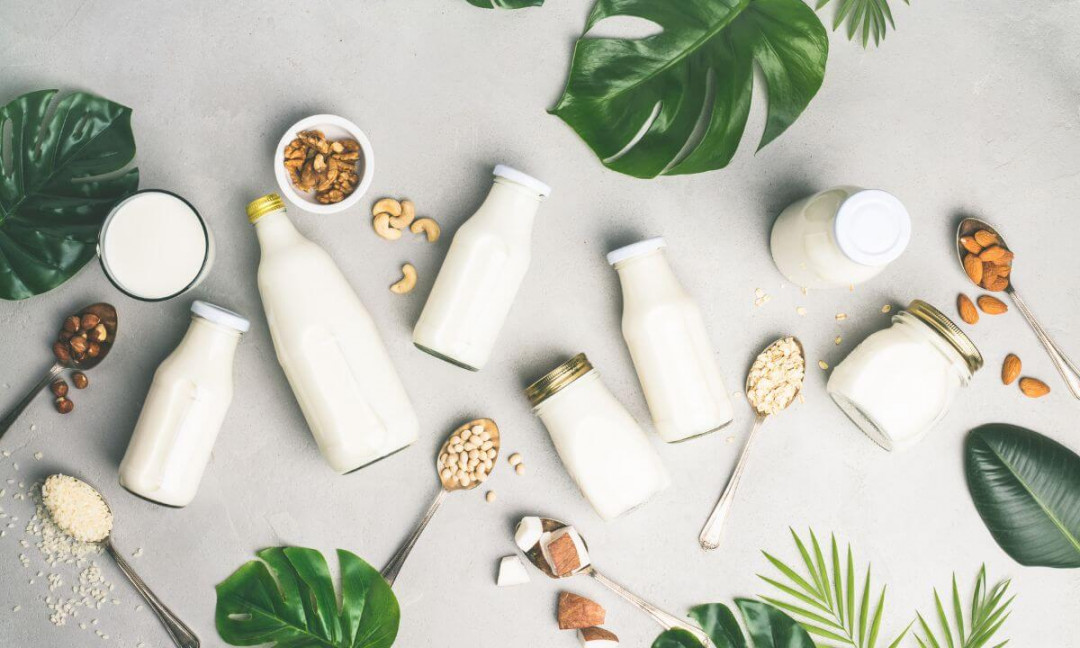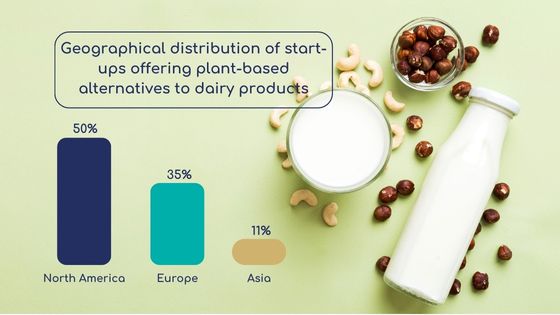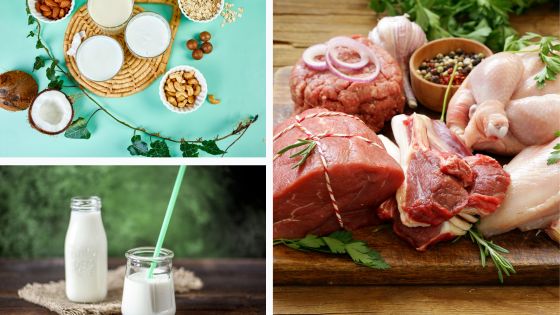
Plant-based alternatives to dairy products: what about nutrition?
Today, plant-based alternatives to animal products have consolidated their place in consumers’ daily lives. There are several reasons for their popularity, including their often reduced environmental impact, as well as the development of diets without animal products or the increasing use of plant-based substitutes for dairy products by lactose intolerants. Whatever the reason, such alternatives should, like their animal-based counterparts, set out to address nutritional quality and health issues.
Plant-based alternatives to dairy products are multiplying on the market
In 2022, global sales of plant-based dairy alternatives amounted to USD 20 billion,[1] with annual growth estimated at 8% over the period 2019-2029.[2] Three main regions predominate in this market in terms of product innovation: North America, which accounts for nearly half of the world’s plant-based dairy substitute start-ups, Europe, with 35% and Asia, accounting for 11%.[3]

There are alternatives to various cheeses, creams, yogurts or frozen desserts. However, not all of these options are equally popular. In France, the most common are substitutes for cheese, milk and finally cream.[4]
Plant-based substitutes for dairy products are varied, and so are the raw materials they are derived from. Several are chosen for their physicochemical and organoleptic properties, allowing them to be used in the same way as dairy products. These include: [4]
-
-
- Nuts and seeds, such as soybeans, cashews or almonds.
- Grains, such as oats or rice.
- Legumes, such as peas.
- Other raw materials, such as coconut.
-
While milk and dairy products are subject to strict regulation, the situation is quite different for plant-based beverages and other plant-based alternatives, which operate within a more opaque regulatory framework and often depend on the general regulations in force.
The nutritional challenges of plant-based substitutes for dairy products
Substitution means the same uses but should also mean setting out to address the same nutritional issues. However, plant-based alternatives are often very different nutritionally from milk and dairy products.
Protein content: An important source choice
Protein levels are generally lower in plant-based dairy substitutes than in origin-derived products. Therefore, while a soft cheese contains 20.2g of protein per 100g, a cashew-based substitute contains 14.5g.[4] However, we should not resort to generalizations – it all depends on the source chosen. A soy drink may contain higher amounts of protein than a whole UHT milk.[4]
In addition, the quality of the protein is just as important as its quantity. Dairy products contain so-called quality proteins, with excellent digestibility. By contrast, often built on a single source of plant protein, the composition of substitutes may display an incomplete amino acid profile compared to the FAO reference protein. For this reason, as part of a balanced plant-based diet, it is recommended to combine cereals and legumes to ensure an optimal protein intake.

Calcium: the solution to fortification
Another key nutrient is calcium. Plant-based substitutes for dairy products contain lower levels of this mineral. However, in order not to lose its many benefits, they can be compensated by enrichment. While a UHT whole milk contains 120 mg calcium/100g, a soy drink contains 12 mg/100g. After enrichment, content can reach 53 mg/100g:[4] this increase is therefore significant but does not compete with dairy products.
In addition, the matrix effect for certain nutrients is worthy of closer scrutiny. This is because certain components of food can stimulate or, on the contrary, alter the absorption of calcium. For example, phytic acid found in certain cereals and legumes such as wheat, buckwheat or soybeans[5] readily binds to calcium, inhibiting its absorption by the intestine.[6] Conversely, lactose and casein in milk have been shown to improve the bioavailability of calcium and other nutrients[7]. Thus, it has been shown that the bioavailability of calcium amounts to 30% in cow’s milk, compared to only 3% in plant-based counterparts.
What is the role of a balanced diet?
Combining plant and animal nutrition sources: the solution for a sustainable and balanced diet?[8]
Diet-related health recommendations differ from country to country. However, overall, the EAT-Lancet scientific commission defines a “healthy diet” as the combination of all categories of food, without eliminating any of them. Thus, following a sustainable and balanced diet means consuming the right amount of each food category, including dairy products. Each recommended amount may vary in different regions of the world, depending on the dietary habits and nutritional needs of individual populations. However, on a global scale, in accordance with the model established by EAT-Lancet, the consumption of dairy and plant-based products (excluding starchy vegetables) should be increased whereas red meat consumption needs to be reduced.

Animal-origin ingredients sometimes more effective
Plant-based alternatives are still sometimes less effective than dairy products. Let’s consider the example of senior nutrition and sports nutrition, both branches of specialized nutrition. In the first case, due to reduced food intake as a result of loss of appetite, taste and other age-related problems, protein intake is reduced. Therefore, it is essential to provide the elderly with high-quality proteins in order to maintain muscle mass in particular. In addition, calcium intake becomes essential for the maintenance of bone health. In the second case, protein is essential for muscle synthesis and recovery. In view of these needs, animal products are proving to be a wiser choice.
And the ingredients in all this?
As with finished products, it is possible to encourage a coexistence of plant- and animal- origin ingredients, especially in the context of protein enrichment. Depending on the type of finished product, the nutritional objective or the target, an animal-based ingredient may be more relevant than its plant-based counterpart or vice versa.
Thus, choosing dairy proteins to enrich a food product means opting for quality proteins in quantity which are more easily assimilated.[9]
Let’s go back to the example of seniors: their protein needs are estimated at 88g/d for an 80kg man and 66g/d for a 60kg woman.[2] However, with age, several problems can alter food intake: taste loss, swallowing disorders, chewing problems, loss of appetite, etc. Thus, it is essential to formulate products that take into account both the protein needs of seniors and their health issues. Enriching dairy products with dairy proteins is therefore a perfect response to these two challenges.
At Lactalis Ingredients, we offer quality solutions for protein enrichment: our range of high-quality, low-fat, taste-neutral proteins. They can be perfectly integrated into dairy products such as yogurt but also into other food solutions such as bars or drinks. Finally, Lactalis Ingredients proteins can be integrated into the formulation of clinical nutrition products, as well as sports and infant nutrition products.
Any question ? Contact-us !
Sources:
[1] Euromonitor International, Passport, Plant-based dairy in world – Datagraphics, août 2023
[2] Y. Park, The impact of Plant-Based Non Dairy Alternative Milk on the Dairy Industry, 2021
[3] Protéines France, Bases de données start-up de Protéines France : focus sur les alternatives aux produits laitiers, mars 2023
[4] ANSES, Table Ciqual
[5] Ulrich Schlemmer, Wenche Frølich, Rafel M. Prieto, and Felix Grases, « Phytate in foods and significance for humans: Food sources, intake, processing, bioavailability, protective role and analysis », Mol Nutr Food Res, vol. 53 suppl 2, no 2, 2009
[6] Harvard T.H Chan, Are anti-nutrients harmful ?, 2022. https://www.hsph.harvard.edu/nutritionsource/anti-nutrients/#:~:text=As%20it%20passes%20through%20the,minerals%20at%20the%20same%20meal.
[7] Chalupa-Krebzdak S, Long CJ, Bohrer BM. Nutrient density and nutritional value of milk and plant-based milk alternatives. International Dairy Journal. 2018;87:84-92. doi:10.1016/j.idairyj.2018.07.018
[8] Commission EAT-Lancet, Rapport de synthèse Alimentation Santé Planète, 2019. https://eatforum.org/content/uploads/2019/07/EAT-Lancet_Commission_Summary_Report_French.pdf
[9] Cerin, JFN 2020 : focus sur les protéines, 21/01/2025. https://www.cerin.org/articles/jfn-2020-focus-sur-les-proteines/
[10] ANSES, Les protéines















